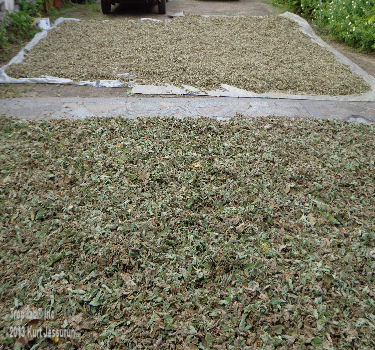 |
 |
| WALTHERIA TINCTURE & TEA (tinctura & infusio WALTHERIA AMERICANA) from AMAZON HERBS® |
| Overview Waltheria Americana (Sleepy morning) is a small tropical shrub; the whole plant (roots, leaves, buds and flowers) is used against chronic asthma. 
This plant has anti inflammatory and antifungal properties. Other uses include: cortex (root bark); chewed as a very effective natural medicine for sore throat. Internally for arthritis, neuralgia, common cold, cough, bronchial phlegm or mucus, diarrhea, eye baths, fatigue; it is used as a bitter tonic. Waltheria is used in Brazil against bronchitis and for cleaning difficult healing wounds. A decoction of the roots and leaves is used for washing badly healing wounds. Used in the Caribbean for bladder infections. This is one of the best plant medicines for sore throats and a good herb for bronchial or bacterial infections. The leaves, flowers and buds are of premium quality and commercially used as herbal tincture and medicinal tea. Phytochemicals Mucilage, tannin, peptide alkaloids, adouetin X,Y,Y1, Z, anthraquinone, Coumarins, Quercetin, kaempferol, 4-quinolone alkaloids, waltherione B and vanessine. A study yielded two flavones, 5,2,5'trihydroxy-3,7,4' trimethoxyflavone and 5,2'dihydroxy-3,7,4',5' tetramethoxyflavone. Pharmacology  In a study of several extracts from different species, five, including Waltheria
(roots and aerial parts), demonstrated moderate antiplasmodial (anti-malarial) activity.
In a study of several extracts from different species, five, including Waltheria
(roots and aerial parts), demonstrated moderate antiplasmodial (anti-malarial) activity.Study of crude extracts from 17 species showed Waltheria to have promising in vitro bactericidal activity against Pneumococcus, including penicillin-resistant strains. In a study three flavonoids were from the whole plant of Waltheria. The flavonoids showed significant dose-dependent inhibition of the production of inflammatory mediator NO, cytokines (TNF-a) and interleukin (IL-12) in activated macrophages, without displaying cytotoxicity. The findings support the use of this plant for inflammatory diseases. Therapeutic applications of flavonoids (polyphenolics) against viral infections. Quercetin is a ubiquitous bioflavonoid* with powerful activity against the production of pro-inflammatory cytokines in macrophages stimulated by lipo-polysaccharide. A mixture of bioflavonoids from Waltheria americana, a plant used for centuries in India for inflammatory disorders, was found to significantly and dose-dependently inhibit the production of the nitric oxide (NO) and the cytokines tumor necrosis factor-a and interleukin (IL)-12, in lipopolysaccharide and g interferon activated murine peritoneal macrophages, without displaying cytotoxicity (cytotoxicity means being toxic to cells). The major constituent of these extracts was quercetin. The flavenoid constituents 5,2', 5'- trihydroxy-3,7,4'-trimethoxyflavone and 5,2,-dihydroxy-3,7,4',5'- tetramethoxyflavone show strong antifungal activity. *Bioflavonoids are a large, heterogeneous group of pigmented plant molecules; they may have emerged because of their ability to cope with the immense free radical load associated with photosynthesis. They are polyphenols, but beyond that they have a wide structural diversity. Over 6000 bioflavonoids have so far been described. For more information on Waltheria, go to the WALTHERIA AMERICANA plant page. Dosage Infusion (herbal tea): 1 - 2 cups daily Tincture: 1 - 2 ml. daily (1 - 2 full droppers) Interaction / side effects There are no interactions and/or side-effects known. Reference Antidiarrhoeal activity of Waltheria americana, Commelina coelestis and Alternanthera repens. Wagner, Warren L., Darrel R. Herbst, and S. H. Sohmer. Manual of the flowering plants of Hawai'i, 1990; 2 vols. Bishop Museum Special Publication 83. Honolulu: University of Hawaii Press and Bishop Museum Press. 1280 p. Flavonoids: promising natural compounds against viral infections. Hovakim Zakaryan, Erik Arabyan, Adrian Oo & Keivan Zandi In Native Hawaiian plant information sheets. Lawai, Kauai: Hawaii Plant Conservation Center. National Tropical Botanical Garden. Unpublished internal papers. Overview of Hawaiian dry forest propagation techniques. Stratton, Lisa, Leslie Hudson, Nova Suenaga, and Barrie Morgan. Newsletter of the Hawaiian Botanical Society 37 (2):13, pp. 15-27, 1998. Zavala MA, Perez S, Perez C, Vargas R, Perez RM. Universidad Autonoma Metropolitana-Xochimilco, Mexico DF, Mexico The above presentation is for informational and educational purposes only. It is based on scientific studies (human, animal, or in vitro), clinical experience, or traditional usage. For many of the conditions discussed, treatment with prescribed (RX) or over - the - counter medication (OTC) is also available. Consult your doctor, practitioner, and/or pharmacist for any health problem and before using dietary supplements or before making any changes in prescribed medications. |
For the right freight rate, please visit our Webstore page! |
|
TROPILAB® INC copyright disclaimer |